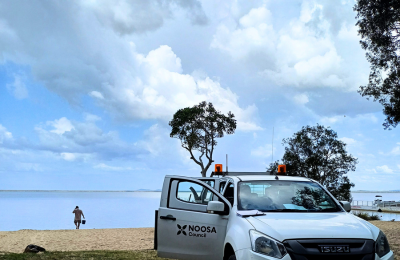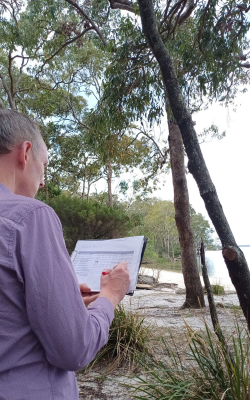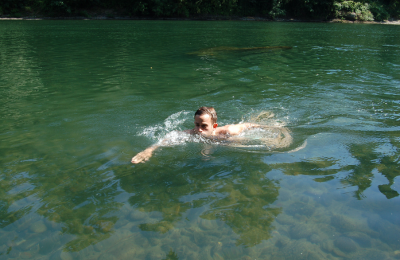Recreational Water Quality Monitoring Program

Noosa Council's local government area has an extensive coastline and many inland water bodies which are popular for recreational activities throughout the year, particularly the more accessible coastal beaches, rivers and lakes.
As part of Council’s Recreational Water Quality Monitoring Program (RWQMP), 10 sites across the Shire are monitored for microbial contamination. This information enables Noosa residents and visitors to make informed decisions about where, when and how they use waterways for recreational activities.
Sampling locations are determined based on their frequency for recreational use and their proximity to stormwater outlets and/or the potential for nutrient or pollutant run-off. Samples are obtained on a fortnightly basis from October through to March, then monthly from April through to September. Samples are also collected within the 24 hours from the next business day following a high rainfall event (>50mm).
All sampling locations test for enterococi - a bacteria found in the intestines of humans and warm-blooded animals, which is used for the detection of faecal contamination in waterways. Enterococci do not generally cause illness but are associated with the presence of pathogens such as bacteria, viruses and parasites which can adversely impact human health.
There is a strong link between large rainfall events and the health of our waterways. With heavy rainfall, harmful microbes have an increased likelihood of being transported into our waterways. Summer storms and heavy downpours can lead to increased run-off from streets, parks and catchments, resulting an increase in enterococci bacteria contamination of our waterways.
The level of microbial contamination can vary on a daily basis. If you enjoy activities in and on Noosa Shire’s waterways, you should be aware of possible water quality issues. Council suggests you check this webpage to stay informed and follow any advisory signage erected by Council in response to elevated bacterial levels.
Current Recreational Water Quality Status:
There are no current warnings in place for all sample sites.
-

Council samples the water quality at the following 10 sites across the Shire:
- Burgess Creek outlet- Sunrise Beach (Marine)
- Sunshine Beach Surf Lifesaving Club (Marine)
- Noosa Heads (Little Cove) (Marine)
- Gympie Tce (Munna Point Caravan Park) (Estuarine)
- Gympie Tce Yacht Club (Pirate Park) (Estuarine)
- Noosa North Shore Campground (240 Wilderness Track) (Marine)
- Lake Cooroibah (Lakeway Drive) (Estuarine)
- Boreen Point Campground (Estuarine)
- Elanda Point Campground (Habitat Noosa) (Estuarine)
-
 Follow these tips and always use your best judgement to decide if it’s safe to enter a waterway:
Follow these tips and always use your best judgement to decide if it’s safe to enter a waterway:- Avoid swimming near stormwater drains.
- Do not swim in water that is discoloured, murky, or smells unpleasant.
- Look out for signs of pollution before entering waterways including floating litter or debris.
- Always follow advice on water quality.
- Avoid swimming if you have an open wound or infection.
- Avoid entering waterways a few days after heaving rainfall events.
If you have any health concerns about being in contact with water, particularly after a flood, you can visit the Queensland Health website or phone 13 HEALTH for advice.
Further information for safe use of our waterways can be found on the Healthy Waterways website.
-
Information on Council’s environmental programs on the Burgess Creek Catchment can be found here. As part of the Recreational Water Quality Monitoring Program (RWQMP), sampling is conducted in the wave zone at Sunrise Beach where the Burgess Creek mouth enters the sea.
Due to the close proximity of the historical night soil and refuse dumps within the Burgess Creek Catchment, and the Sewerage Treatment Plant at Burgess Creek, Council does not recommend primary contact or drinking water from this location. As always, Council recommends that contact with waterways be limited following heavy rain.
-
If water quality testing confirms elevated levels of enterococci, temporary warning signs will be installed in the affected location. If a warning sign is in place, it means you should avoid contact with the water. Activities where you will be immersed in the water, or even have limbs wet, are not recommended.
The sign says: Recent water monitoring has detected elevated levels of bacteria at this location. Recreational use, such as swimming and full body immersion is not recommended at this time
When a warning sign is in place, Council advises against the following activities:
- swimming
- jet skiing
- kite surfing
- wading
- rowing
- fishing
- activities where your limbs get wet regularly.
The warning signs will remain in place for as long as necessary and will be removed promptly when the health hazard no longer exists.
The enterococci trigger levels for installing and removing the warning signs are based on the National Guidelines for Managing Risks in Recreational Waters 2008.
Please be aware; Council is unable to obtain real-time results for bacterial levels or know what levels are present at all times. Water samples take approximately 24 hours for laboratory analysis. The results from monitoring indicate the bacterial levels which were present at the time the samples were taken.
-
To report an urgent water pollution event (e.g. soil being washed into a drain or waterway), phone Council’s customer service centre on (07) 5329 6500 to enable a prompt response to the issue.
If the water pollution issue is not urgent, you can lodge a complaint by contacting Council using one of the methods below:
- Online request
- Phone: (07) 5329 6500
- Email: mail@noosa.qld.gov.au
- In person: Council Office, 9 Pelican Street, Tewantin
Examples of non-urgent erosion and sediment control issues within the Noosa Council area include:
- Uncovered soil or cement left beside roadside gutters, drains or waterways (in dry weather)
- Lack of adequate erosion and sediment controls (i.e. sediment fences) on a building or construction site.
